Cultural Diversity's Impact on UK Grocery Employee Performance
VerifiedAdded on 2022/12/27
|48
|15083
|57
Report
AI Summary
This dissertation investigates the effects of cultural diversity on employee performance within the UK grocery sector. The study begins with an abstract outlining the research's purpose, aim, objectives, and methodology. The introduction provides an overview, defines the research aim to investigate cultural diversity's impact, and lists specific objectives, research questions, and study background. A literature review explores the concept of cultural diversity, its benefits, challenges, and its relationship with employee performance, along with ways to promote it. The methodology chapter details the research paradigms, approach, strategies, instruments (questionnaires), data collection, sampling, and ethical considerations. The subsequent chapters present data analysis, findings, conclusions, and recommendations, including managerial implications and directions for future research. The research utilizes quantitative methods, including questionnaires and frequency distribution analysis to evaluate the data. The conclusion summarizes the findings, and recommendations suggest improvements to the research topic. The report highlights the importance of cultural diversity in the workplace and its impact on employee performance within the UK grocery industry.
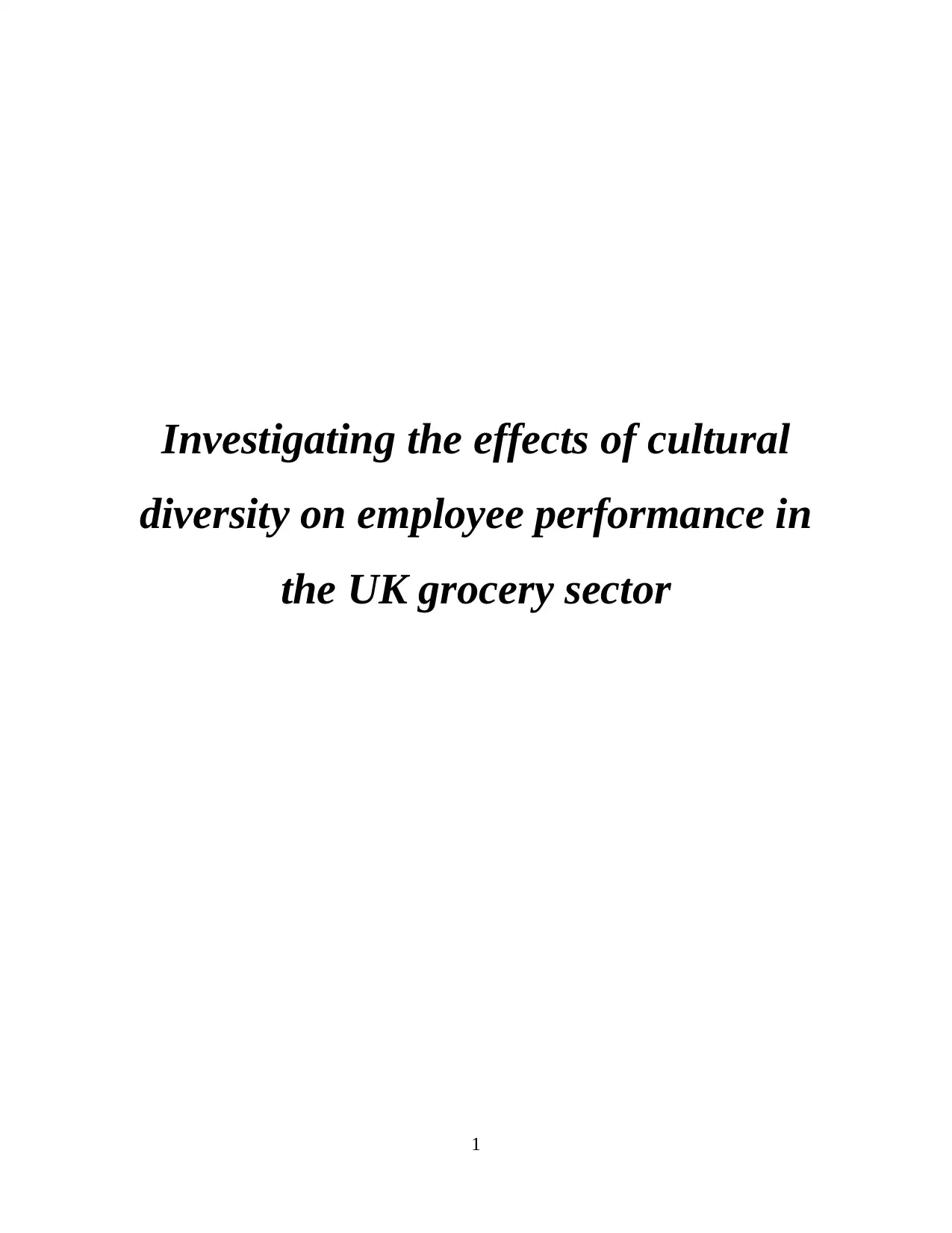
Investigating the effects of cultural
diversity on employee performance in
the UK grocery sector
1
diversity on employee performance in
the UK grocery sector
1
Paraphrase This Document
Need a fresh take? Get an instant paraphrase of this document with our AI Paraphraser
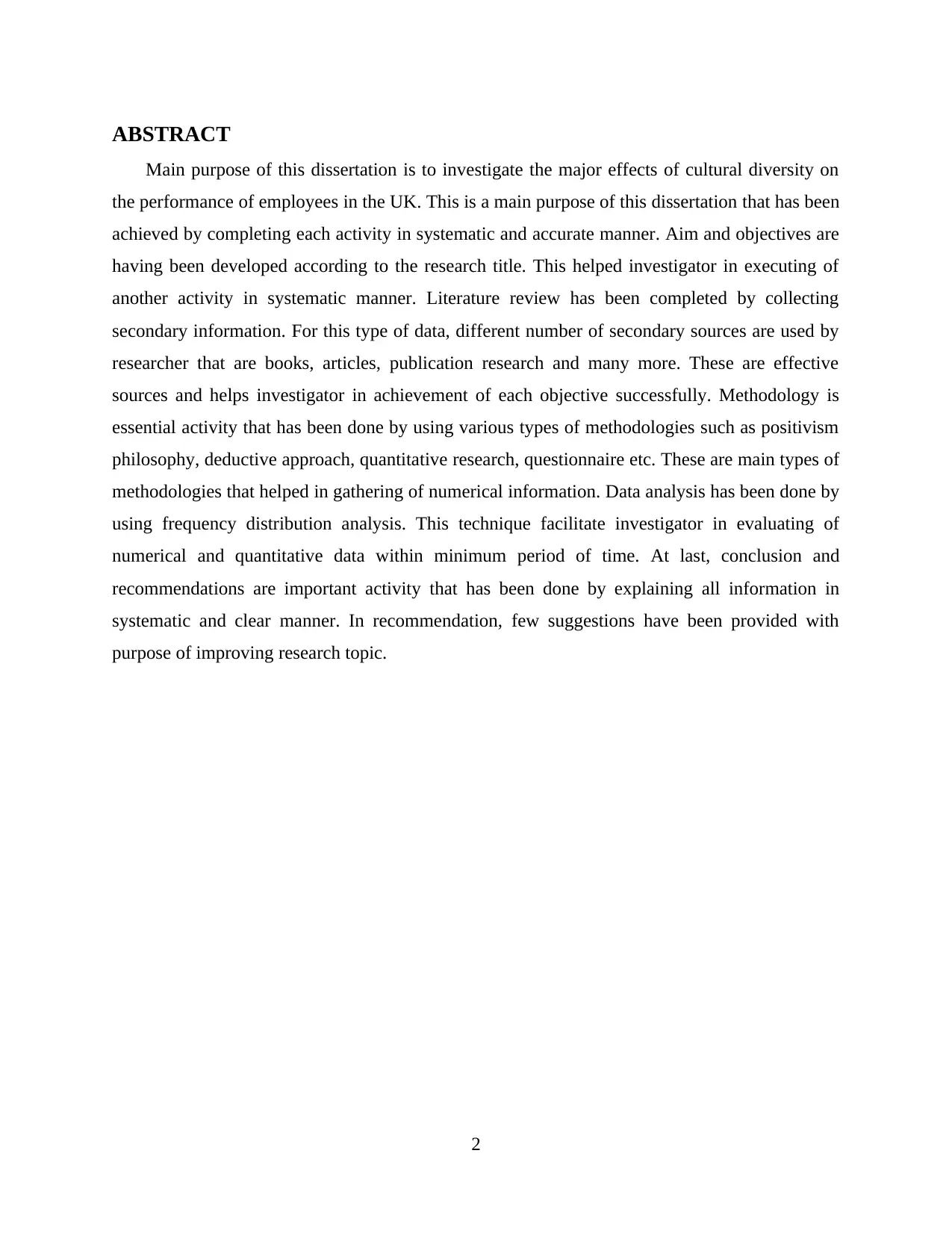
ABSTRACT
Main purpose of this dissertation is to investigate the major effects of cultural diversity on
the performance of employees in the UK. This is a main purpose of this dissertation that has been
achieved by completing each activity in systematic and accurate manner. Aim and objectives are
having been developed according to the research title. This helped investigator in executing of
another activity in systematic manner. Literature review has been completed by collecting
secondary information. For this type of data, different number of secondary sources are used by
researcher that are books, articles, publication research and many more. These are effective
sources and helps investigator in achievement of each objective successfully. Methodology is
essential activity that has been done by using various types of methodologies such as positivism
philosophy, deductive approach, quantitative research, questionnaire etc. These are main types of
methodologies that helped in gathering of numerical information. Data analysis has been done by
using frequency distribution analysis. This technique facilitate investigator in evaluating of
numerical and quantitative data within minimum period of time. At last, conclusion and
recommendations are important activity that has been done by explaining all information in
systematic and clear manner. In recommendation, few suggestions have been provided with
purpose of improving research topic.
2
Main purpose of this dissertation is to investigate the major effects of cultural diversity on
the performance of employees in the UK. This is a main purpose of this dissertation that has been
achieved by completing each activity in systematic and accurate manner. Aim and objectives are
having been developed according to the research title. This helped investigator in executing of
another activity in systematic manner. Literature review has been completed by collecting
secondary information. For this type of data, different number of secondary sources are used by
researcher that are books, articles, publication research and many more. These are effective
sources and helps investigator in achievement of each objective successfully. Methodology is
essential activity that has been done by using various types of methodologies such as positivism
philosophy, deductive approach, quantitative research, questionnaire etc. These are main types of
methodologies that helped in gathering of numerical information. Data analysis has been done by
using frequency distribution analysis. This technique facilitate investigator in evaluating of
numerical and quantitative data within minimum period of time. At last, conclusion and
recommendations are important activity that has been done by explaining all information in
systematic and clear manner. In recommendation, few suggestions have been provided with
purpose of improving research topic.
2
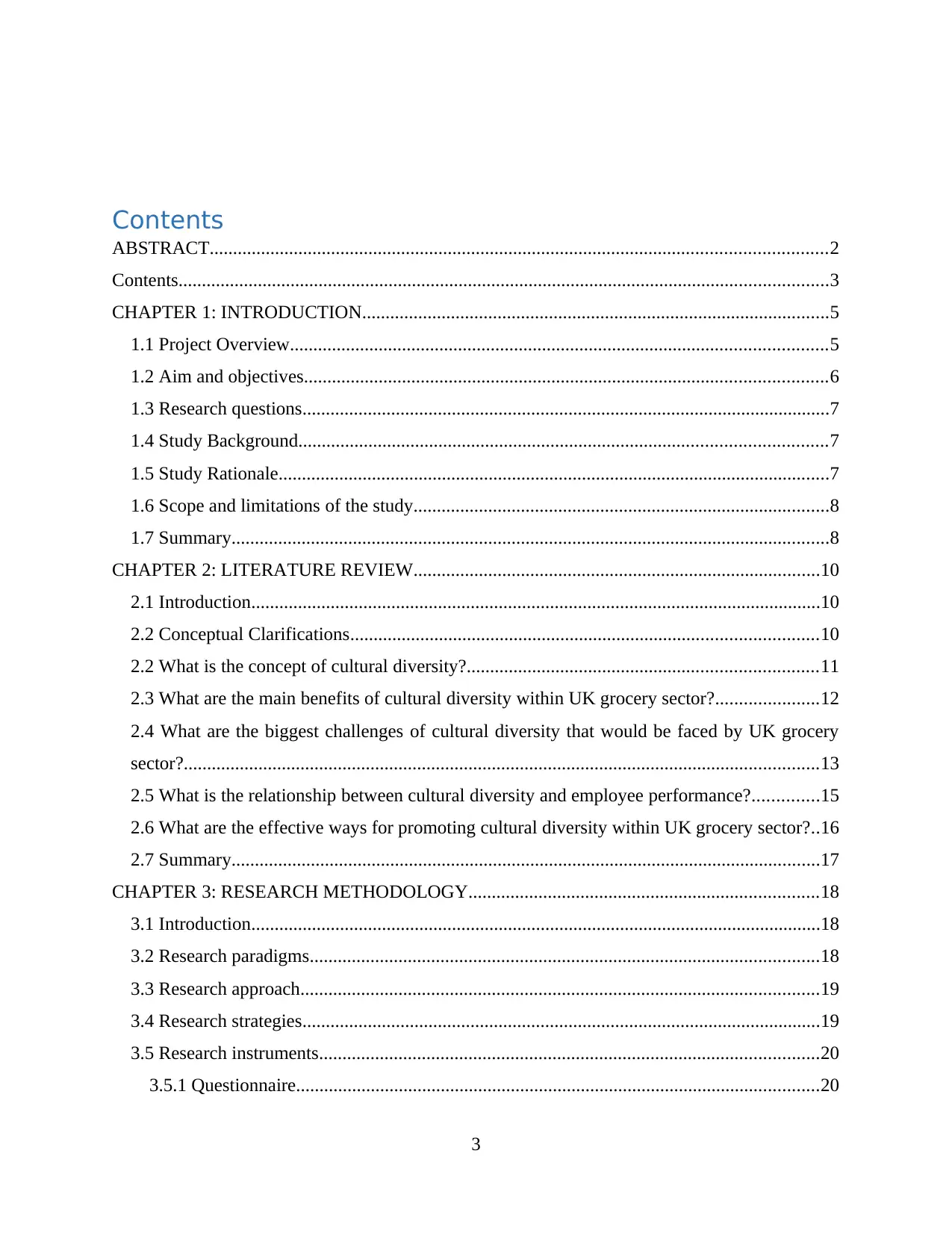
Contents
ABSTRACT....................................................................................................................................2
Contents...........................................................................................................................................3
CHAPTER 1: INTRODUCTION....................................................................................................5
1.1 Project Overview...................................................................................................................5
1.2 Aim and objectives................................................................................................................6
1.3 Research questions.................................................................................................................7
1.4 Study Background.................................................................................................................7
1.5 Study Rationale......................................................................................................................7
1.6 Scope and limitations of the study.........................................................................................8
1.7 Summary................................................................................................................................8
CHAPTER 2: LITERATURE REVIEW.......................................................................................10
2.1 Introduction..........................................................................................................................10
2.2 Conceptual Clarifications....................................................................................................10
2.2 What is the concept of cultural diversity?...........................................................................11
2.3 What are the main benefits of cultural diversity within UK grocery sector?......................12
2.4 What are the biggest challenges of cultural diversity that would be faced by UK grocery
sector?........................................................................................................................................13
2.5 What is the relationship between cultural diversity and employee performance?..............15
2.6 What are the effective ways for promoting cultural diversity within UK grocery sector?..16
2.7 Summary..............................................................................................................................17
CHAPTER 3: RESEARCH METHODOLOGY...........................................................................18
3.1 Introduction..........................................................................................................................18
3.2 Research paradigms.............................................................................................................18
3.3 Research approach...............................................................................................................19
3.4 Research strategies...............................................................................................................19
3.5 Research instruments...........................................................................................................20
3.5.1 Questionnaire................................................................................................................20
3
ABSTRACT....................................................................................................................................2
Contents...........................................................................................................................................3
CHAPTER 1: INTRODUCTION....................................................................................................5
1.1 Project Overview...................................................................................................................5
1.2 Aim and objectives................................................................................................................6
1.3 Research questions.................................................................................................................7
1.4 Study Background.................................................................................................................7
1.5 Study Rationale......................................................................................................................7
1.6 Scope and limitations of the study.........................................................................................8
1.7 Summary................................................................................................................................8
CHAPTER 2: LITERATURE REVIEW.......................................................................................10
2.1 Introduction..........................................................................................................................10
2.2 Conceptual Clarifications....................................................................................................10
2.2 What is the concept of cultural diversity?...........................................................................11
2.3 What are the main benefits of cultural diversity within UK grocery sector?......................12
2.4 What are the biggest challenges of cultural diversity that would be faced by UK grocery
sector?........................................................................................................................................13
2.5 What is the relationship between cultural diversity and employee performance?..............15
2.6 What are the effective ways for promoting cultural diversity within UK grocery sector?..16
2.7 Summary..............................................................................................................................17
CHAPTER 3: RESEARCH METHODOLOGY...........................................................................18
3.1 Introduction..........................................................................................................................18
3.2 Research paradigms.............................................................................................................18
3.3 Research approach...............................................................................................................19
3.4 Research strategies...............................................................................................................19
3.5 Research instruments...........................................................................................................20
3.5.1 Questionnaire................................................................................................................20
3
⊘ This is a preview!⊘
Do you want full access?
Subscribe today to unlock all pages.

Trusted by 1+ million students worldwide
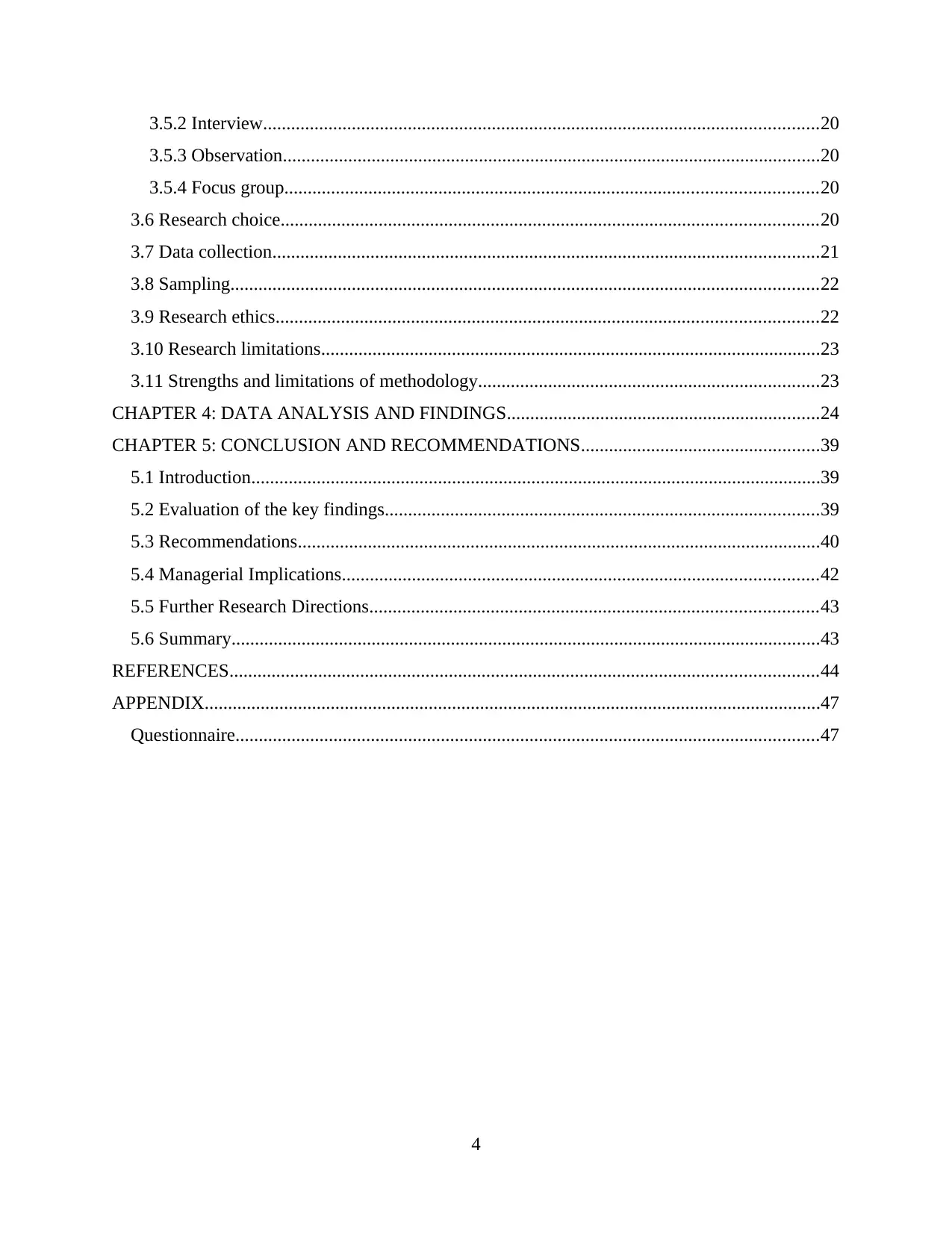
3.5.2 Interview.......................................................................................................................20
3.5.3 Observation...................................................................................................................20
3.5.4 Focus group..................................................................................................................20
3.6 Research choice...................................................................................................................20
3.7 Data collection.....................................................................................................................21
3.8 Sampling..............................................................................................................................22
3.9 Research ethics....................................................................................................................22
3.10 Research limitations...........................................................................................................23
3.11 Strengths and limitations of methodology.........................................................................23
CHAPTER 4: DATA ANALYSIS AND FINDINGS...................................................................24
CHAPTER 5: CONCLUSION AND RECOMMENDATIONS...................................................39
5.1 Introduction..........................................................................................................................39
5.2 Evaluation of the key findings.............................................................................................39
5.3 Recommendations................................................................................................................40
5.4 Managerial Implications......................................................................................................42
5.5 Further Research Directions................................................................................................43
5.6 Summary..............................................................................................................................43
REFERENCES..............................................................................................................................44
APPENDIX....................................................................................................................................47
Questionnaire.............................................................................................................................47
4
3.5.3 Observation...................................................................................................................20
3.5.4 Focus group..................................................................................................................20
3.6 Research choice...................................................................................................................20
3.7 Data collection.....................................................................................................................21
3.8 Sampling..............................................................................................................................22
3.9 Research ethics....................................................................................................................22
3.10 Research limitations...........................................................................................................23
3.11 Strengths and limitations of methodology.........................................................................23
CHAPTER 4: DATA ANALYSIS AND FINDINGS...................................................................24
CHAPTER 5: CONCLUSION AND RECOMMENDATIONS...................................................39
5.1 Introduction..........................................................................................................................39
5.2 Evaluation of the key findings.............................................................................................39
5.3 Recommendations................................................................................................................40
5.4 Managerial Implications......................................................................................................42
5.5 Further Research Directions................................................................................................43
5.6 Summary..............................................................................................................................43
REFERENCES..............................................................................................................................44
APPENDIX....................................................................................................................................47
Questionnaire.............................................................................................................................47
4
Paraphrase This Document
Need a fresh take? Get an instant paraphrase of this document with our AI Paraphraser
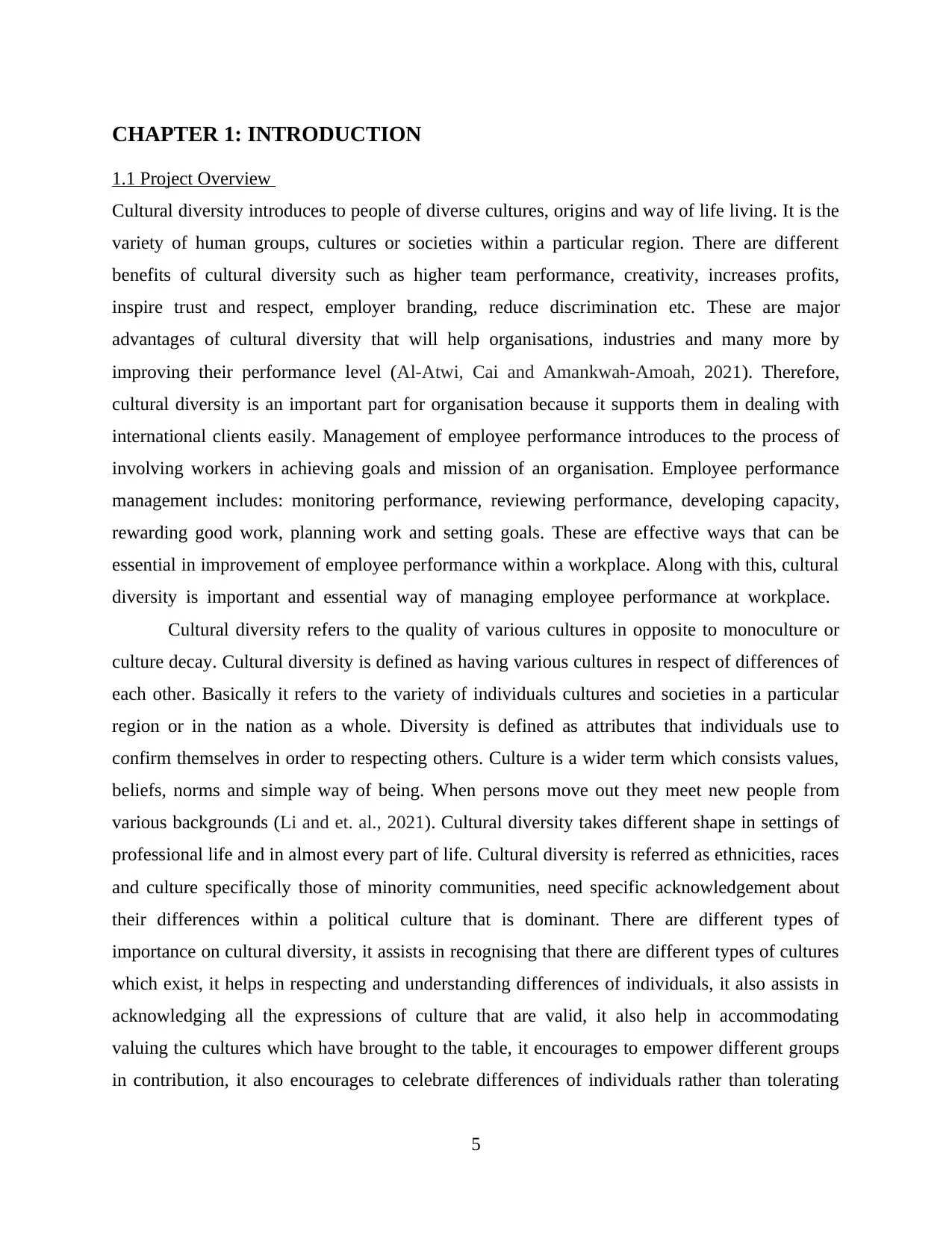
CHAPTER 1: INTRODUCTION
1.1 Project Overview
Cultural diversity introduces to people of diverse cultures, origins and way of life living. It is the
variety of human groups, cultures or societies within a particular region. There are different
benefits of cultural diversity such as higher team performance, creativity, increases profits,
inspire trust and respect, employer branding, reduce discrimination etc. These are major
advantages of cultural diversity that will help organisations, industries and many more by
improving their performance level (Al-Atwi, Cai and Amankwah-Amoah, 2021). Therefore,
cultural diversity is an important part for organisation because it supports them in dealing with
international clients easily. Management of employee performance introduces to the process of
involving workers in achieving goals and mission of an organisation. Employee performance
management includes: monitoring performance, reviewing performance, developing capacity,
rewarding good work, planning work and setting goals. These are effective ways that can be
essential in improvement of employee performance within a workplace. Along with this, cultural
diversity is important and essential way of managing employee performance at workplace.
Cultural diversity refers to the quality of various cultures in opposite to monoculture or
culture decay. Cultural diversity is defined as having various cultures in respect of differences of
each other. Basically it refers to the variety of individuals cultures and societies in a particular
region or in the nation as a whole. Diversity is defined as attributes that individuals use to
confirm themselves in order to respecting others. Culture is a wider term which consists values,
beliefs, norms and simple way of being. When persons move out they meet new people from
various backgrounds (Li and et. al., 2021). Cultural diversity takes different shape in settings of
professional life and in almost every part of life. Cultural diversity is referred as ethnicities, races
and culture specifically those of minority communities, need specific acknowledgement about
their differences within a political culture that is dominant. There are different types of
importance on cultural diversity, it assists in recognising that there are different types of cultures
which exist, it helps in respecting and understanding differences of individuals, it also assists in
acknowledging all the expressions of culture that are valid, it also help in accommodating
valuing the cultures which have brought to the table, it encourages to empower different groups
in contribution, it also encourages to celebrate differences of individuals rather than tolerating
5
1.1 Project Overview
Cultural diversity introduces to people of diverse cultures, origins and way of life living. It is the
variety of human groups, cultures or societies within a particular region. There are different
benefits of cultural diversity such as higher team performance, creativity, increases profits,
inspire trust and respect, employer branding, reduce discrimination etc. These are major
advantages of cultural diversity that will help organisations, industries and many more by
improving their performance level (Al-Atwi, Cai and Amankwah-Amoah, 2021). Therefore,
cultural diversity is an important part for organisation because it supports them in dealing with
international clients easily. Management of employee performance introduces to the process of
involving workers in achieving goals and mission of an organisation. Employee performance
management includes: monitoring performance, reviewing performance, developing capacity,
rewarding good work, planning work and setting goals. These are effective ways that can be
essential in improvement of employee performance within a workplace. Along with this, cultural
diversity is important and essential way of managing employee performance at workplace.
Cultural diversity refers to the quality of various cultures in opposite to monoculture or
culture decay. Cultural diversity is defined as having various cultures in respect of differences of
each other. Basically it refers to the variety of individuals cultures and societies in a particular
region or in the nation as a whole. Diversity is defined as attributes that individuals use to
confirm themselves in order to respecting others. Culture is a wider term which consists values,
beliefs, norms and simple way of being. When persons move out they meet new people from
various backgrounds (Li and et. al., 2021). Cultural diversity takes different shape in settings of
professional life and in almost every part of life. Cultural diversity is referred as ethnicities, races
and culture specifically those of minority communities, need specific acknowledgement about
their differences within a political culture that is dominant. There are different types of
importance on cultural diversity, it assists in recognising that there are different types of cultures
which exist, it helps in respecting and understanding differences of individuals, it also assists in
acknowledging all the expressions of culture that are valid, it also help in accommodating
valuing the cultures which have brought to the table, it encourages to empower different groups
in contribution, it also encourages to celebrate differences of individuals rather than tolerating
5
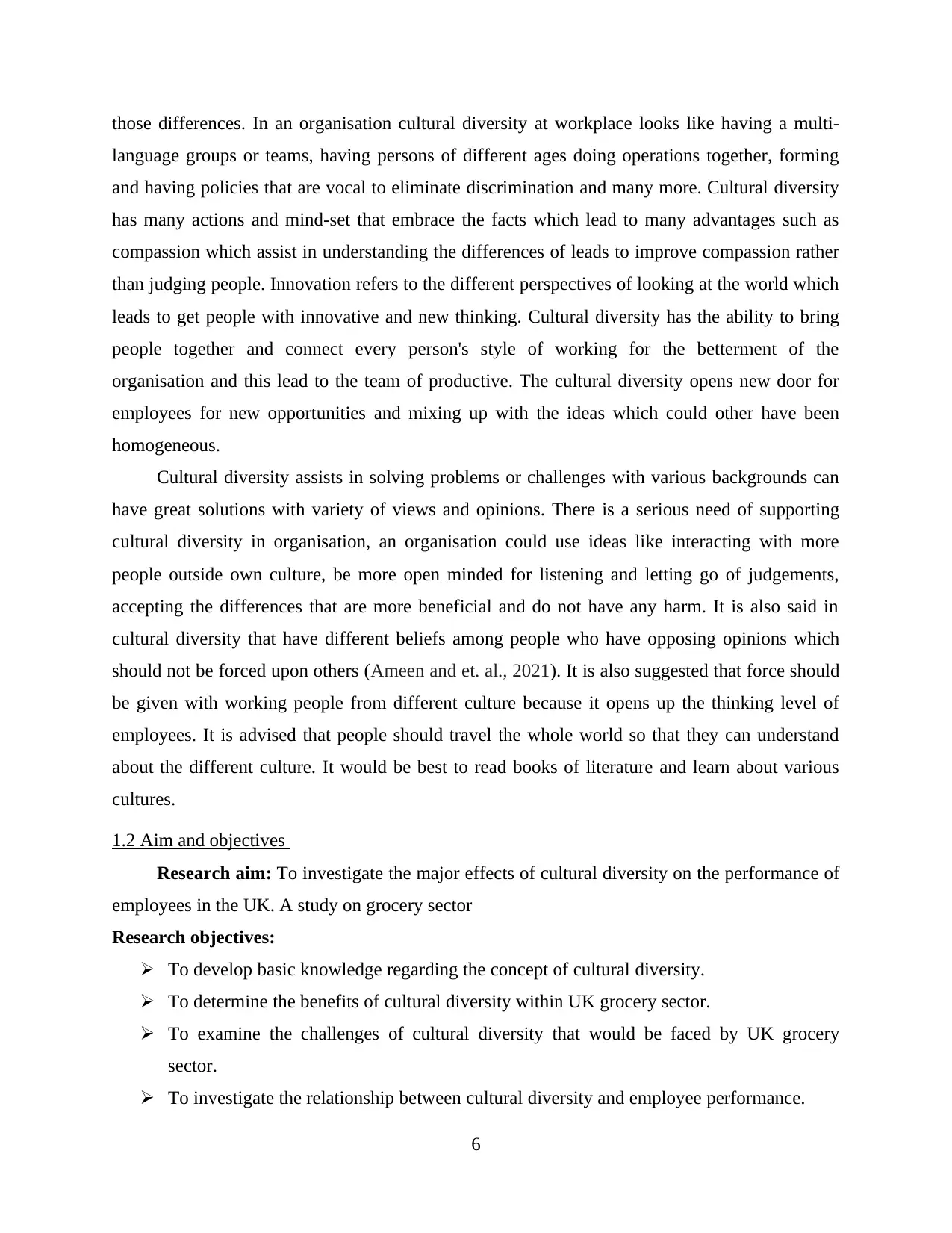
those differences. In an organisation cultural diversity at workplace looks like having a multi-
language groups or teams, having persons of different ages doing operations together, forming
and having policies that are vocal to eliminate discrimination and many more. Cultural diversity
has many actions and mind-set that embrace the facts which lead to many advantages such as
compassion which assist in understanding the differences of leads to improve compassion rather
than judging people. Innovation refers to the different perspectives of looking at the world which
leads to get people with innovative and new thinking. Cultural diversity has the ability to bring
people together and connect every person's style of working for the betterment of the
organisation and this lead to the team of productive. The cultural diversity opens new door for
employees for new opportunities and mixing up with the ideas which could other have been
homogeneous.
Cultural diversity assists in solving problems or challenges with various backgrounds can
have great solutions with variety of views and opinions. There is a serious need of supporting
cultural diversity in organisation, an organisation could use ideas like interacting with more
people outside own culture, be more open minded for listening and letting go of judgements,
accepting the differences that are more beneficial and do not have any harm. It is also said in
cultural diversity that have different beliefs among people who have opposing opinions which
should not be forced upon others (Ameen and et. al., 2021). It is also suggested that force should
be given with working people from different culture because it opens up the thinking level of
employees. It is advised that people should travel the whole world so that they can understand
about the different culture. It would be best to read books of literature and learn about various
cultures.
1.2 Aim and objectives
Research aim: To investigate the major effects of cultural diversity on the performance of
employees in the UK. A study on grocery sector
Research objectives:
To develop basic knowledge regarding the concept of cultural diversity.
To determine the benefits of cultural diversity within UK grocery sector.
To examine the challenges of cultural diversity that would be faced by UK grocery
sector.
To investigate the relationship between cultural diversity and employee performance.
6
language groups or teams, having persons of different ages doing operations together, forming
and having policies that are vocal to eliminate discrimination and many more. Cultural diversity
has many actions and mind-set that embrace the facts which lead to many advantages such as
compassion which assist in understanding the differences of leads to improve compassion rather
than judging people. Innovation refers to the different perspectives of looking at the world which
leads to get people with innovative and new thinking. Cultural diversity has the ability to bring
people together and connect every person's style of working for the betterment of the
organisation and this lead to the team of productive. The cultural diversity opens new door for
employees for new opportunities and mixing up with the ideas which could other have been
homogeneous.
Cultural diversity assists in solving problems or challenges with various backgrounds can
have great solutions with variety of views and opinions. There is a serious need of supporting
cultural diversity in organisation, an organisation could use ideas like interacting with more
people outside own culture, be more open minded for listening and letting go of judgements,
accepting the differences that are more beneficial and do not have any harm. It is also said in
cultural diversity that have different beliefs among people who have opposing opinions which
should not be forced upon others (Ameen and et. al., 2021). It is also suggested that force should
be given with working people from different culture because it opens up the thinking level of
employees. It is advised that people should travel the whole world so that they can understand
about the different culture. It would be best to read books of literature and learn about various
cultures.
1.2 Aim and objectives
Research aim: To investigate the major effects of cultural diversity on the performance of
employees in the UK. A study on grocery sector
Research objectives:
To develop basic knowledge regarding the concept of cultural diversity.
To determine the benefits of cultural diversity within UK grocery sector.
To examine the challenges of cultural diversity that would be faced by UK grocery
sector.
To investigate the relationship between cultural diversity and employee performance.
6
⊘ This is a preview!⊘
Do you want full access?
Subscribe today to unlock all pages.

Trusted by 1+ million students worldwide
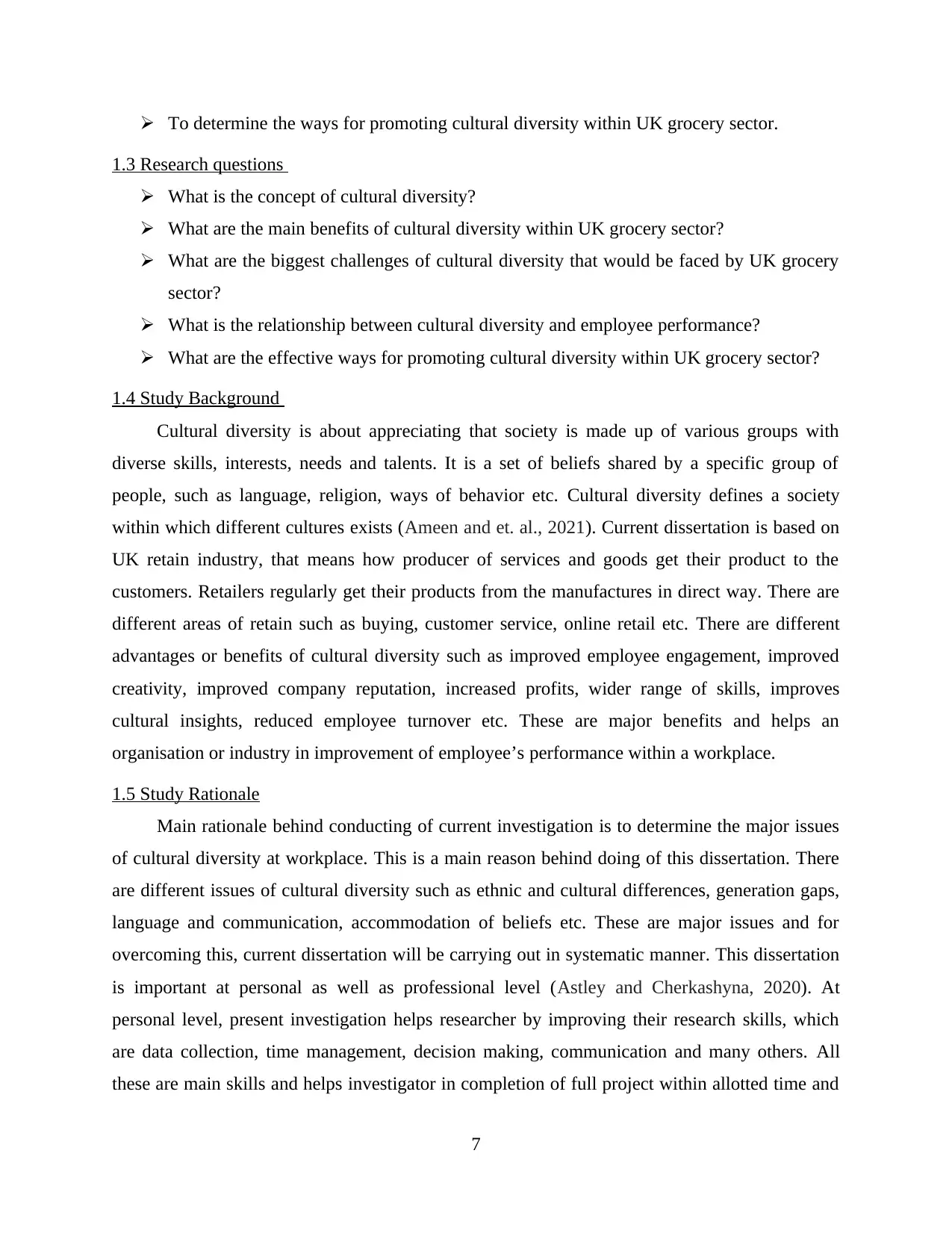
To determine the ways for promoting cultural diversity within UK grocery sector.
1.3 Research questions
What is the concept of cultural diversity?
What are the main benefits of cultural diversity within UK grocery sector?
What are the biggest challenges of cultural diversity that would be faced by UK grocery
sector?
What is the relationship between cultural diversity and employee performance?
What are the effective ways for promoting cultural diversity within UK grocery sector?
1.4 Study Background
Cultural diversity is about appreciating that society is made up of various groups with
diverse skills, interests, needs and talents. It is a set of beliefs shared by a specific group of
people, such as language, religion, ways of behavior etc. Cultural diversity defines a society
within which different cultures exists (Ameen and et. al., 2021). Current dissertation is based on
UK retain industry, that means how producer of services and goods get their product to the
customers. Retailers regularly get their products from the manufactures in direct way. There are
different areas of retain such as buying, customer service, online retail etc. There are different
advantages or benefits of cultural diversity such as improved employee engagement, improved
creativity, improved company reputation, increased profits, wider range of skills, improves
cultural insights, reduced employee turnover etc. These are major benefits and helps an
organisation or industry in improvement of employee’s performance within a workplace.
1.5 Study Rationale
Main rationale behind conducting of current investigation is to determine the major issues
of cultural diversity at workplace. This is a main reason behind doing of this dissertation. There
are different issues of cultural diversity such as ethnic and cultural differences, generation gaps,
language and communication, accommodation of beliefs etc. These are major issues and for
overcoming this, current dissertation will be carrying out in systematic manner. This dissertation
is important at personal as well as professional level (Astley and Cherkashyna, 2020). At
personal level, present investigation helps researcher by improving their research skills, which
are data collection, time management, decision making, communication and many others. All
these are main skills and helps investigator in completion of full project within allotted time and
7
1.3 Research questions
What is the concept of cultural diversity?
What are the main benefits of cultural diversity within UK grocery sector?
What are the biggest challenges of cultural diversity that would be faced by UK grocery
sector?
What is the relationship between cultural diversity and employee performance?
What are the effective ways for promoting cultural diversity within UK grocery sector?
1.4 Study Background
Cultural diversity is about appreciating that society is made up of various groups with
diverse skills, interests, needs and talents. It is a set of beliefs shared by a specific group of
people, such as language, religion, ways of behavior etc. Cultural diversity defines a society
within which different cultures exists (Ameen and et. al., 2021). Current dissertation is based on
UK retain industry, that means how producer of services and goods get their product to the
customers. Retailers regularly get their products from the manufactures in direct way. There are
different areas of retain such as buying, customer service, online retail etc. There are different
advantages or benefits of cultural diversity such as improved employee engagement, improved
creativity, improved company reputation, increased profits, wider range of skills, improves
cultural insights, reduced employee turnover etc. These are major benefits and helps an
organisation or industry in improvement of employee’s performance within a workplace.
1.5 Study Rationale
Main rationale behind conducting of current investigation is to determine the major issues
of cultural diversity at workplace. This is a main reason behind doing of this dissertation. There
are different issues of cultural diversity such as ethnic and cultural differences, generation gaps,
language and communication, accommodation of beliefs etc. These are major issues and for
overcoming this, current dissertation will be carrying out in systematic manner. This dissertation
is important at personal as well as professional level (Astley and Cherkashyna, 2020). At
personal level, present investigation helps researcher by improving their research skills, which
are data collection, time management, decision making, communication and many others. All
these are main skills and helps investigator in completion of full project within allotted time and
7
Paraphrase This Document
Need a fresh take? Get an instant paraphrase of this document with our AI Paraphraser
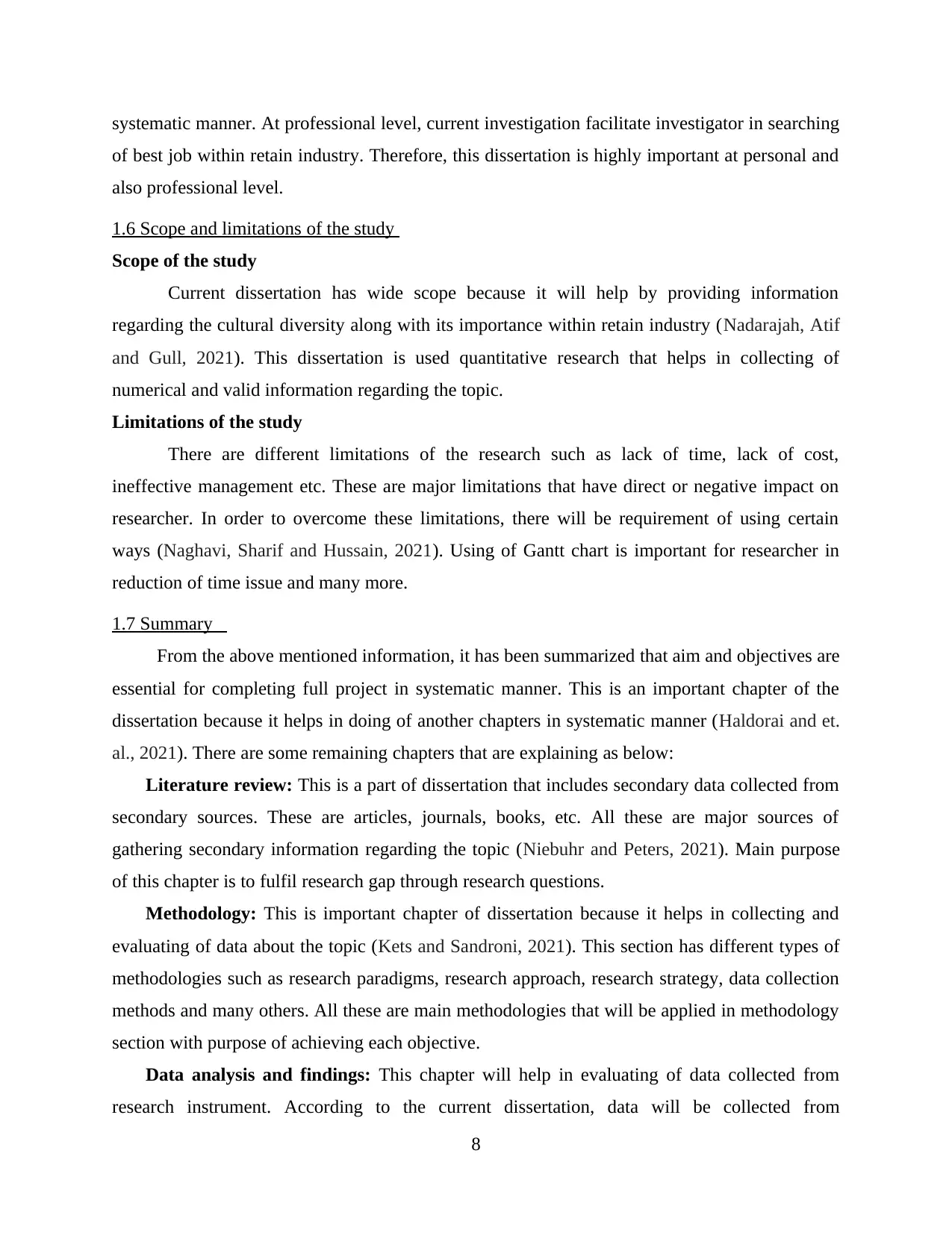
systematic manner. At professional level, current investigation facilitate investigator in searching
of best job within retain industry. Therefore, this dissertation is highly important at personal and
also professional level.
1.6 Scope and limitations of the study
Scope of the study
Current dissertation has wide scope because it will help by providing information
regarding the cultural diversity along with its importance within retain industry (Nadarajah, Atif
and Gull, 2021). This dissertation is used quantitative research that helps in collecting of
numerical and valid information regarding the topic.
Limitations of the study
There are different limitations of the research such as lack of time, lack of cost,
ineffective management etc. These are major limitations that have direct or negative impact on
researcher. In order to overcome these limitations, there will be requirement of using certain
ways (Naghavi, Sharif and Hussain, 2021). Using of Gantt chart is important for researcher in
reduction of time issue and many more.
1.7 Summary
From the above mentioned information, it has been summarized that aim and objectives are
essential for completing full project in systematic manner. This is an important chapter of the
dissertation because it helps in doing of another chapters in systematic manner (Haldorai and et.
al., 2021). There are some remaining chapters that are explaining as below:
Literature review: This is a part of dissertation that includes secondary data collected from
secondary sources. These are articles, journals, books, etc. All these are major sources of
gathering secondary information regarding the topic (Niebuhr and Peters, 2021). Main purpose
of this chapter is to fulfil research gap through research questions.
Methodology: This is important chapter of dissertation because it helps in collecting and
evaluating of data about the topic (Kets and Sandroni, 2021). This section has different types of
methodologies such as research paradigms, research approach, research strategy, data collection
methods and many others. All these are main methodologies that will be applied in methodology
section with purpose of achieving each objective.
Data analysis and findings: This chapter will help in evaluating of data collected from
research instrument. According to the current dissertation, data will be collected from
8
of best job within retain industry. Therefore, this dissertation is highly important at personal and
also professional level.
1.6 Scope and limitations of the study
Scope of the study
Current dissertation has wide scope because it will help by providing information
regarding the cultural diversity along with its importance within retain industry (Nadarajah, Atif
and Gull, 2021). This dissertation is used quantitative research that helps in collecting of
numerical and valid information regarding the topic.
Limitations of the study
There are different limitations of the research such as lack of time, lack of cost,
ineffective management etc. These are major limitations that have direct or negative impact on
researcher. In order to overcome these limitations, there will be requirement of using certain
ways (Naghavi, Sharif and Hussain, 2021). Using of Gantt chart is important for researcher in
reduction of time issue and many more.
1.7 Summary
From the above mentioned information, it has been summarized that aim and objectives are
essential for completing full project in systematic manner. This is an important chapter of the
dissertation because it helps in doing of another chapters in systematic manner (Haldorai and et.
al., 2021). There are some remaining chapters that are explaining as below:
Literature review: This is a part of dissertation that includes secondary data collected from
secondary sources. These are articles, journals, books, etc. All these are major sources of
gathering secondary information regarding the topic (Niebuhr and Peters, 2021). Main purpose
of this chapter is to fulfil research gap through research questions.
Methodology: This is important chapter of dissertation because it helps in collecting and
evaluating of data about the topic (Kets and Sandroni, 2021). This section has different types of
methodologies such as research paradigms, research approach, research strategy, data collection
methods and many others. All these are main methodologies that will be applied in methodology
section with purpose of achieving each objective.
Data analysis and findings: This chapter will help in evaluating of data collected from
research instrument. According to the current dissertation, data will be collected from
8
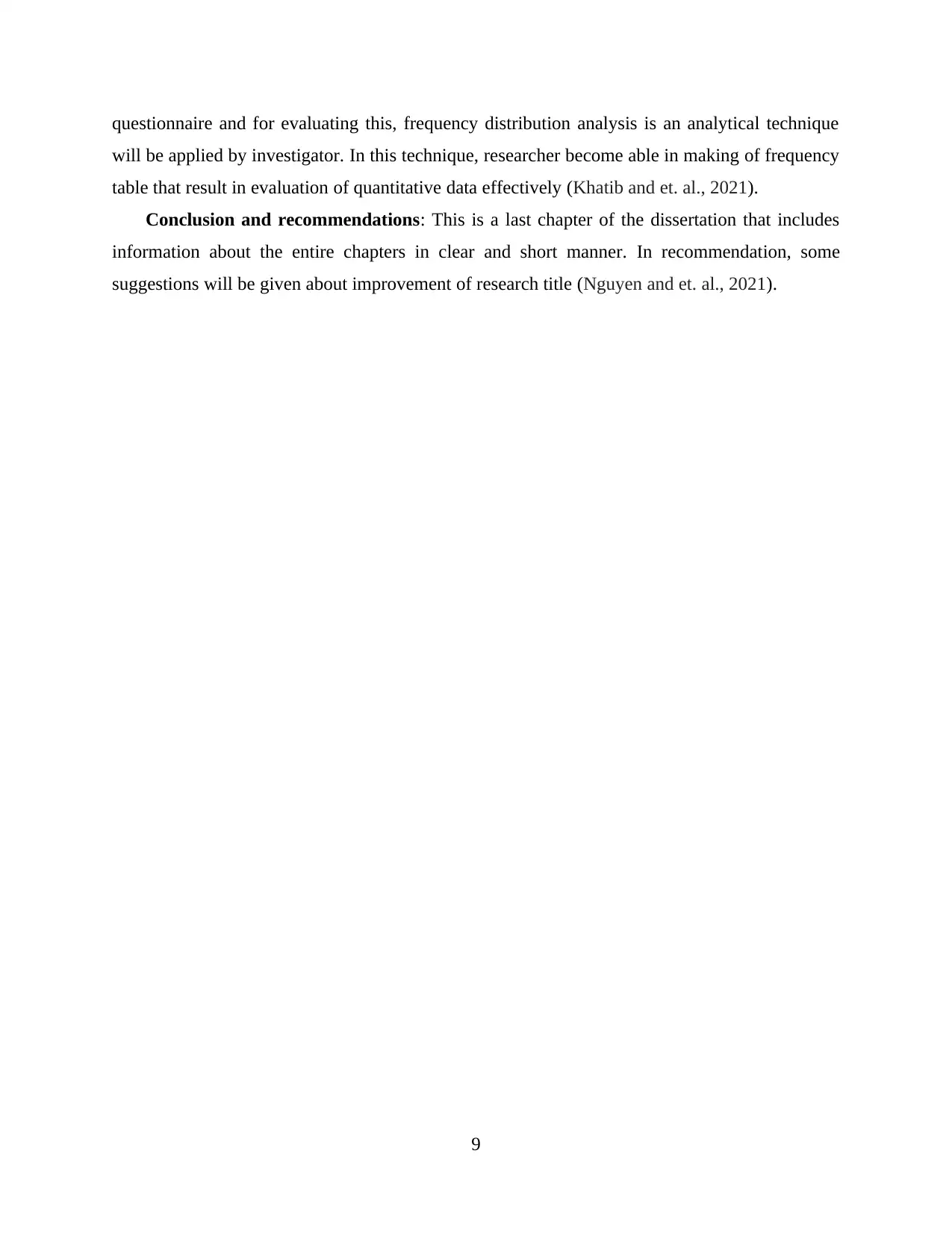
questionnaire and for evaluating this, frequency distribution analysis is an analytical technique
will be applied by investigator. In this technique, researcher become able in making of frequency
table that result in evaluation of quantitative data effectively (Khatib and et. al., 2021).
Conclusion and recommendations: This is a last chapter of the dissertation that includes
information about the entire chapters in clear and short manner. In recommendation, some
suggestions will be given about improvement of research title (Nguyen and et. al., 2021).
9
will be applied by investigator. In this technique, researcher become able in making of frequency
table that result in evaluation of quantitative data effectively (Khatib and et. al., 2021).
Conclusion and recommendations: This is a last chapter of the dissertation that includes
information about the entire chapters in clear and short manner. In recommendation, some
suggestions will be given about improvement of research title (Nguyen and et. al., 2021).
9
⊘ This is a preview!⊘
Do you want full access?
Subscribe today to unlock all pages.

Trusted by 1+ million students worldwide
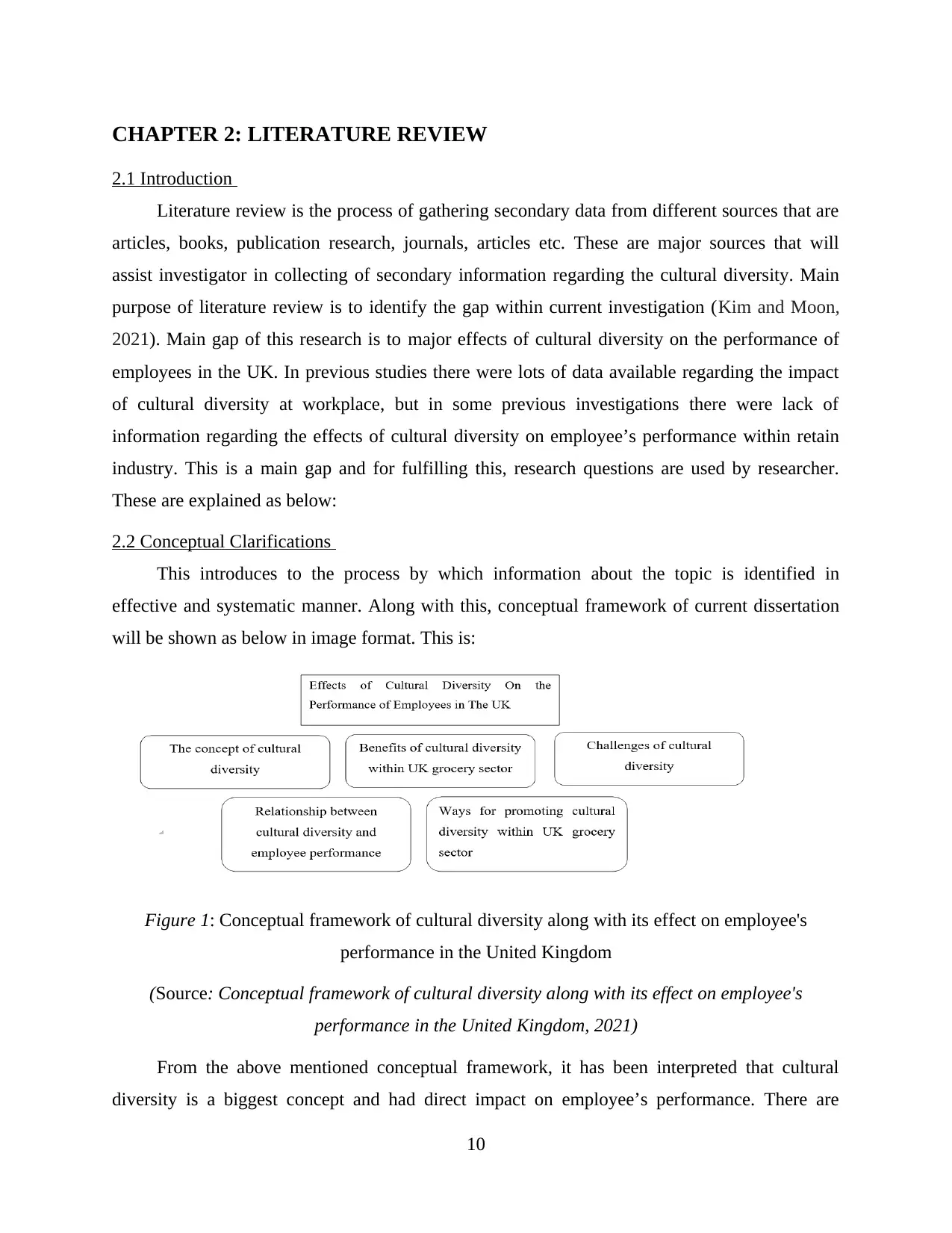
CHAPTER 2: LITERATURE REVIEW
2.1 Introduction
Literature review is the process of gathering secondary data from different sources that are
articles, books, publication research, journals, articles etc. These are major sources that will
assist investigator in collecting of secondary information regarding the cultural diversity. Main
purpose of literature review is to identify the gap within current investigation (Kim and Moon,
2021). Main gap of this research is to major effects of cultural diversity on the performance of
employees in the UK. In previous studies there were lots of data available regarding the impact
of cultural diversity at workplace, but in some previous investigations there were lack of
information regarding the effects of cultural diversity on employee’s performance within retain
industry. This is a main gap and for fulfilling this, research questions are used by researcher.
These are explained as below:
2.2 Conceptual Clarifications
This introduces to the process by which information about the topic is identified in
effective and systematic manner. Along with this, conceptual framework of current dissertation
will be shown as below in image format. This is:
Figure 1: Conceptual framework of cultural diversity along with its effect on employee's
performance in the United Kingdom
(Source: Conceptual framework of cultural diversity along with its effect on employee's
performance in the United Kingdom, 2021)
From the above mentioned conceptual framework, it has been interpreted that cultural
diversity is a biggest concept and had direct impact on employee’s performance. There are
10
2.1 Introduction
Literature review is the process of gathering secondary data from different sources that are
articles, books, publication research, journals, articles etc. These are major sources that will
assist investigator in collecting of secondary information regarding the cultural diversity. Main
purpose of literature review is to identify the gap within current investigation (Kim and Moon,
2021). Main gap of this research is to major effects of cultural diversity on the performance of
employees in the UK. In previous studies there were lots of data available regarding the impact
of cultural diversity at workplace, but in some previous investigations there were lack of
information regarding the effects of cultural diversity on employee’s performance within retain
industry. This is a main gap and for fulfilling this, research questions are used by researcher.
These are explained as below:
2.2 Conceptual Clarifications
This introduces to the process by which information about the topic is identified in
effective and systematic manner. Along with this, conceptual framework of current dissertation
will be shown as below in image format. This is:
Figure 1: Conceptual framework of cultural diversity along with its effect on employee's
performance in the United Kingdom
(Source: Conceptual framework of cultural diversity along with its effect on employee's
performance in the United Kingdom, 2021)
From the above mentioned conceptual framework, it has been interpreted that cultural
diversity is a biggest concept and had direct impact on employee’s performance. There are
10
Paraphrase This Document
Need a fresh take? Get an instant paraphrase of this document with our AI Paraphraser
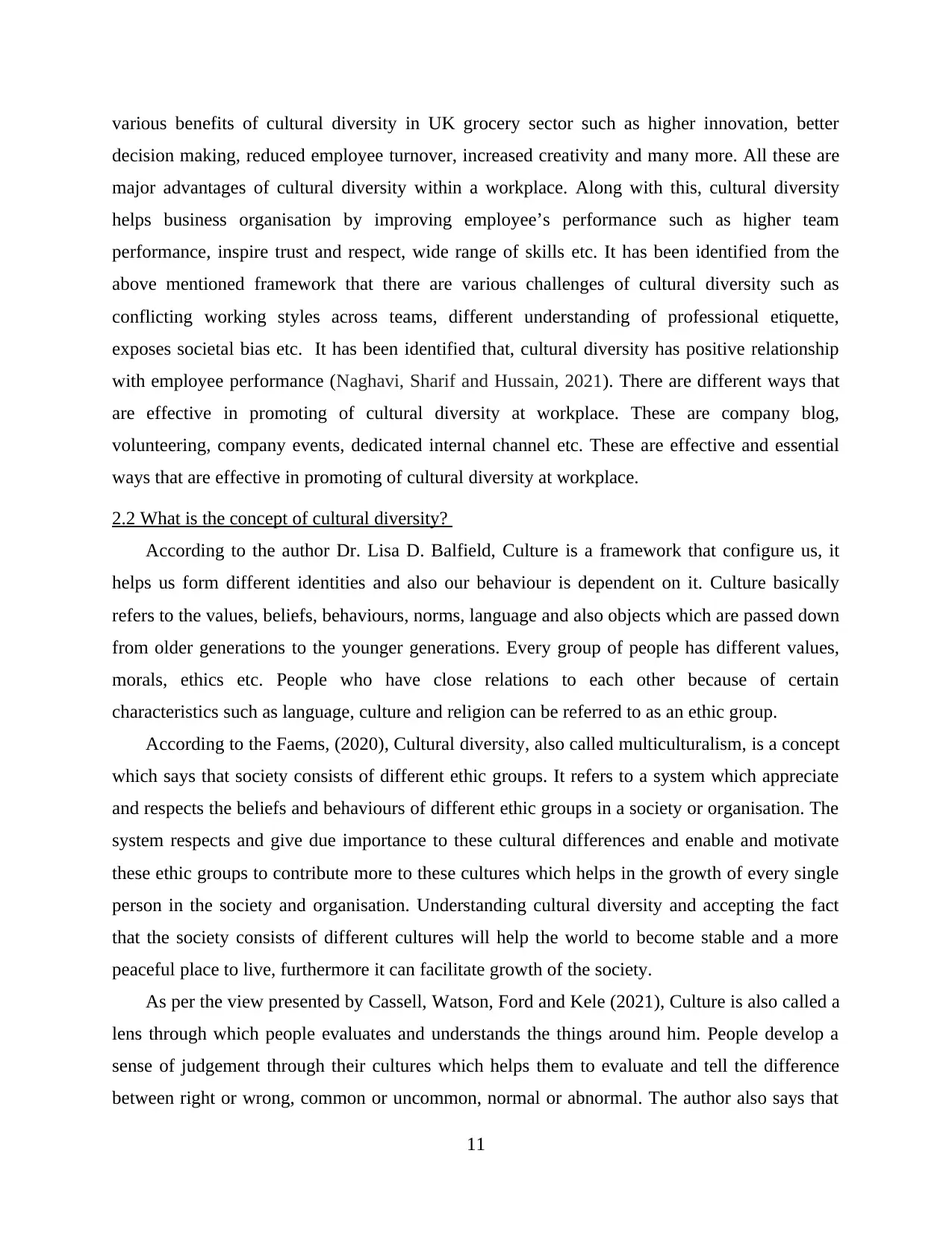
various benefits of cultural diversity in UK grocery sector such as higher innovation, better
decision making, reduced employee turnover, increased creativity and many more. All these are
major advantages of cultural diversity within a workplace. Along with this, cultural diversity
helps business organisation by improving employee’s performance such as higher team
performance, inspire trust and respect, wide range of skills etc. It has been identified from the
above mentioned framework that there are various challenges of cultural diversity such as
conflicting working styles across teams, different understanding of professional etiquette,
exposes societal bias etc. It has been identified that, cultural diversity has positive relationship
with employee performance (Naghavi, Sharif and Hussain, 2021). There are different ways that
are effective in promoting of cultural diversity at workplace. These are company blog,
volunteering, company events, dedicated internal channel etc. These are effective and essential
ways that are effective in promoting of cultural diversity at workplace.
2.2 What is the concept of cultural diversity?
According to the author Dr. Lisa D. Balfield, Culture is a framework that configure us, it
helps us form different identities and also our behaviour is dependent on it. Culture basically
refers to the values, beliefs, behaviours, norms, language and also objects which are passed down
from older generations to the younger generations. Every group of people has different values,
morals, ethics etc. People who have close relations to each other because of certain
characteristics such as language, culture and religion can be referred to as an ethic group.
According to the Faems, (2020), Cultural diversity, also called multiculturalism, is a concept
which says that society consists of different ethic groups. It refers to a system which appreciate
and respects the beliefs and behaviours of different ethic groups in a society or organisation. The
system respects and give due importance to these cultural differences and enable and motivate
these ethic groups to contribute more to these cultures which helps in the growth of every single
person in the society and organisation. Understanding cultural diversity and accepting the fact
that the society consists of different cultures will help the world to become stable and a more
peaceful place to live, furthermore it can facilitate growth of the society.
As per the view presented by Cassell, Watson, Ford and Kele (2021), Culture is also called a
lens through which people evaluates and understands the things around him. People develop a
sense of judgement through their cultures which helps them to evaluate and tell the difference
between right or wrong, common or uncommon, normal or abnormal. The author also says that
11
decision making, reduced employee turnover, increased creativity and many more. All these are
major advantages of cultural diversity within a workplace. Along with this, cultural diversity
helps business organisation by improving employee’s performance such as higher team
performance, inspire trust and respect, wide range of skills etc. It has been identified from the
above mentioned framework that there are various challenges of cultural diversity such as
conflicting working styles across teams, different understanding of professional etiquette,
exposes societal bias etc. It has been identified that, cultural diversity has positive relationship
with employee performance (Naghavi, Sharif and Hussain, 2021). There are different ways that
are effective in promoting of cultural diversity at workplace. These are company blog,
volunteering, company events, dedicated internal channel etc. These are effective and essential
ways that are effective in promoting of cultural diversity at workplace.
2.2 What is the concept of cultural diversity?
According to the author Dr. Lisa D. Balfield, Culture is a framework that configure us, it
helps us form different identities and also our behaviour is dependent on it. Culture basically
refers to the values, beliefs, behaviours, norms, language and also objects which are passed down
from older generations to the younger generations. Every group of people has different values,
morals, ethics etc. People who have close relations to each other because of certain
characteristics such as language, culture and religion can be referred to as an ethic group.
According to the Faems, (2020), Cultural diversity, also called multiculturalism, is a concept
which says that society consists of different ethic groups. It refers to a system which appreciate
and respects the beliefs and behaviours of different ethic groups in a society or organisation. The
system respects and give due importance to these cultural differences and enable and motivate
these ethic groups to contribute more to these cultures which helps in the growth of every single
person in the society and organisation. Understanding cultural diversity and accepting the fact
that the society consists of different cultures will help the world to become stable and a more
peaceful place to live, furthermore it can facilitate growth of the society.
As per the view presented by Cassell, Watson, Ford and Kele (2021), Culture is also called a
lens through which people evaluates and understands the things around him. People develop a
sense of judgement through their cultures which helps them to evaluate and tell the difference
between right or wrong, common or uncommon, normal or abnormal. The author also says that
11
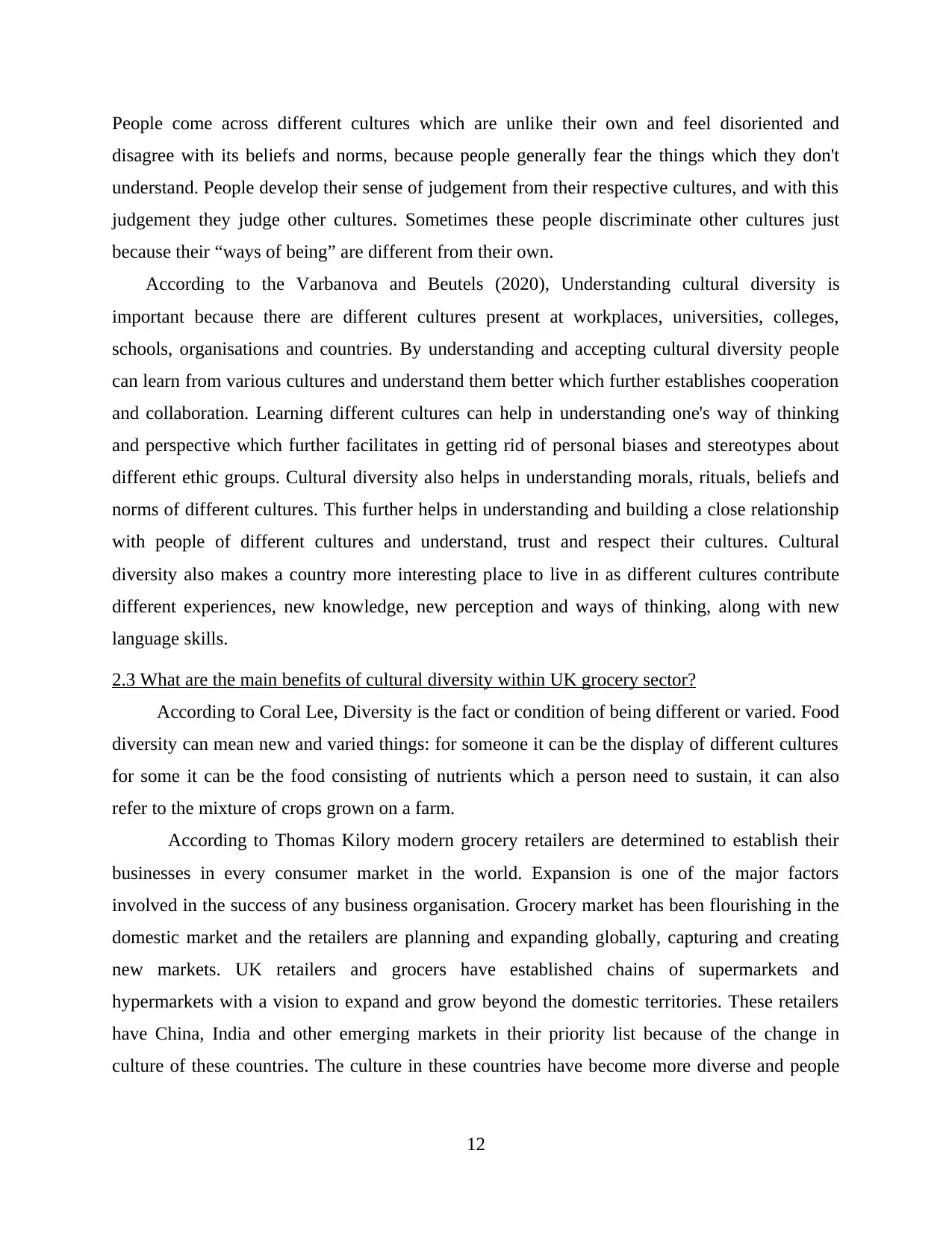
People come across different cultures which are unlike their own and feel disoriented and
disagree with its beliefs and norms, because people generally fear the things which they don't
understand. People develop their sense of judgement from their respective cultures, and with this
judgement they judge other cultures. Sometimes these people discriminate other cultures just
because their “ways of being” are different from their own.
According to the Varbanova and Beutels (2020), Understanding cultural diversity is
important because there are different cultures present at workplaces, universities, colleges,
schools, organisations and countries. By understanding and accepting cultural diversity people
can learn from various cultures and understand them better which further establishes cooperation
and collaboration. Learning different cultures can help in understanding one's way of thinking
and perspective which further facilitates in getting rid of personal biases and stereotypes about
different ethic groups. Cultural diversity also helps in understanding morals, rituals, beliefs and
norms of different cultures. This further helps in understanding and building a close relationship
with people of different cultures and understand, trust and respect their cultures. Cultural
diversity also makes a country more interesting place to live in as different cultures contribute
different experiences, new knowledge, new perception and ways of thinking, along with new
language skills.
2.3 What are the main benefits of cultural diversity within UK grocery sector?
According to Coral Lee, Diversity is the fact or condition of being different or varied. Food
diversity can mean new and varied things: for someone it can be the display of different cultures
for some it can be the food consisting of nutrients which a person need to sustain, it can also
refer to the mixture of crops grown on a farm.
According to Thomas Kilory modern grocery retailers are determined to establish their
businesses in every consumer market in the world. Expansion is one of the major factors
involved in the success of any business organisation. Grocery market has been flourishing in the
domestic market and the retailers are planning and expanding globally, capturing and creating
new markets. UK retailers and grocers have established chains of supermarkets and
hypermarkets with a vision to expand and grow beyond the domestic territories. These retailers
have China, India and other emerging markets in their priority list because of the change in
culture of these countries. The culture in these countries have become more diverse and people
12
disagree with its beliefs and norms, because people generally fear the things which they don't
understand. People develop their sense of judgement from their respective cultures, and with this
judgement they judge other cultures. Sometimes these people discriminate other cultures just
because their “ways of being” are different from their own.
According to the Varbanova and Beutels (2020), Understanding cultural diversity is
important because there are different cultures present at workplaces, universities, colleges,
schools, organisations and countries. By understanding and accepting cultural diversity people
can learn from various cultures and understand them better which further establishes cooperation
and collaboration. Learning different cultures can help in understanding one's way of thinking
and perspective which further facilitates in getting rid of personal biases and stereotypes about
different ethic groups. Cultural diversity also helps in understanding morals, rituals, beliefs and
norms of different cultures. This further helps in understanding and building a close relationship
with people of different cultures and understand, trust and respect their cultures. Cultural
diversity also makes a country more interesting place to live in as different cultures contribute
different experiences, new knowledge, new perception and ways of thinking, along with new
language skills.
2.3 What are the main benefits of cultural diversity within UK grocery sector?
According to Coral Lee, Diversity is the fact or condition of being different or varied. Food
diversity can mean new and varied things: for someone it can be the display of different cultures
for some it can be the food consisting of nutrients which a person need to sustain, it can also
refer to the mixture of crops grown on a farm.
According to Thomas Kilory modern grocery retailers are determined to establish their
businesses in every consumer market in the world. Expansion is one of the major factors
involved in the success of any business organisation. Grocery market has been flourishing in the
domestic market and the retailers are planning and expanding globally, capturing and creating
new markets. UK retailers and grocers have established chains of supermarkets and
hypermarkets with a vision to expand and grow beyond the domestic territories. These retailers
have China, India and other emerging markets in their priority list because of the change in
culture of these countries. The culture in these countries have become more diverse and people
12
⊘ This is a preview!⊘
Do you want full access?
Subscribe today to unlock all pages.

Trusted by 1+ million students worldwide
1 out of 48
Related Documents
Your All-in-One AI-Powered Toolkit for Academic Success.
+13062052269
info@desklib.com
Available 24*7 on WhatsApp / Email
![[object Object]](/_next/static/media/star-bottom.7253800d.svg)
Unlock your academic potential
Copyright © 2020–2025 A2Z Services. All Rights Reserved. Developed and managed by ZUCOL.





